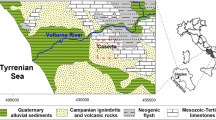Abstract
Groundwater vulnerability assessment schemes are used for the estimation of potential groundwater contamination at different scales and on different administrative levels. However, the term vulnerability is not standardized and the available methods are not able to give a unique assessment of vulnerability creating thus uncertainty in the interpretation and in further application concerning decision creation processes. To judge the information of vulnerability maps certainly and to value the general trends of vulnerability assessment of different methods, four different vulnerability methods of the parametric system group have been applied on a karst area in southwestern Germany to perform a comparative assessment and correlation of these vulnerability assessment methods, namely DRASTIC, PI, EPIK, and GLA. It is shown that by means of simple statistical considerations the first highly different vulnerability maps could be made more coherent after reclassification. The reclassified vulnerability assessments show a more consistent vulnerability distribution pattern and provide the possibility of area-wide validation of the maps as the chosen vulnerability classification is theoretically connected to the mean transit time of percolation water and is largely independent of the applied vulnerability assessment method.




Similar content being viewed by others
References
Aller L, Bennet T, Lehr JH, Petty RJ, Hackett G (1987) DRASTIC: a standardized system for evaluating ground water pollution potential using hydrogeological settings. National Water Well Association, Dublin, 266 pp
Doerfliger N, Zwahlen F (1998) Practical guide, groundwater vulnerability map** in karstic regions (EPIK). Swiss Agency for the Environment, Forests and Landscape (SAEFL), Bern, 56 pp
Gogu RC, Dassargue A (2000) Current trends and future challenges in groundwater vulnerability assessment using overlay and index methods. Environ Geol 30(6):549–559
Goldscheider (2002) Hydrogeology and vulnerability of karst systems—examples from the northern Alps and the Swabian Alb. PhD thesis, Schr Angew Geol Karlsruhe, Karlsruhe, 236 pp
Goldscheider N (2003) Karst groundwater vulnerability map**: application of a new method in the Swabian Alb. Hydrogeol J 13(4):555–564
Goldscheider N, Klute M, Sturm S, Hötzl H (2000) The PI method: a GIS based approach to map** groundwater vulnerability with special consideration of karst aquifers. Z Angew Geol 463:157–166
Goldscheider N, Hötzl H, Fries W, Jordan P (2001) Validation of a vulnerability map (EPIK) with tracer tests. In: 7th conference on limestone, hydrology and fissured media, 20–22 Sept 2001, Besançon, France, pp 167–170
Hötling B, Haertle T, Hohberger KH, Nachtigall KH, Villinger E, Weinzierl W, Wrobel JP (1995) Konzept zur Ermittlung der Schutzfunktion der Grundwasserüberdeckung [concept for the evaluation of the protective function of the layers overlying groundwater]. Geol Jahrb C63:5–24
Isaak EH (1989) An introduction to applied geostatistics. Oxford University Press, New York, 561 pp
Tenhäff G, Käss W (1987) Karsthydrologische untersuchungen im bereich der bauschlotter platte (nordbaden) [karsthydrological investigations]. J Geol Landesamt Baden-Württemberg 29:209–254
Zwahlen F (ed) (2004) Vulnerability and risk map** for the protection of carbonate (karst) aquifers, final report (COST Action 620). European Commission, Directorate XII Science, Research and Development, Report EUR 20912, Brussels, 297 pp
Author information
Authors and Affiliations
Corresponding author
Rights and permissions
About this article
Cite this article
Neukum, C., Hötzl, H. Standardization of vulnerability maps. Environ Geol 51, 689–694 (2007). https://doi.org/10.1007/s00254-006-0380-4
Received:
Accepted:
Published:
Issue Date:
DOI: https://doi.org/10.1007/s00254-006-0380-4




